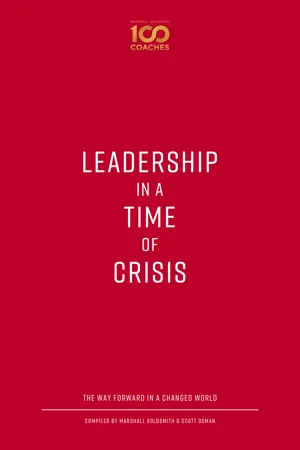
- 173 pages
- English
- ePUB (mobile friendly)
- Available on iOS & Android
About this book
The founder of Marshall Goldsmith 100 Coaches presents insight on business and leadership in the age of COVID-19 from some of today's top consultants. This informative volumeoffers expert advice on navigating a business through today's global pandemic. Some of the world's most effective consultants give their perspectives on all areas of employee and customer growth and engagement. They also consider the ramifications of COVID-19 on people; the healthcare system; local, national and global economies; and on our businesses. In early March 2020, members of the nonprofit organization Marshall Goldsmith 100 Coaches began discussing the developments and repercussions of current events with each other as well as global leaders around the world. Thirty-seven contributors offer helpful and forward-thinking insights on how we can create more value in the companies we serve and better the lives of our coworkers and communities. Leadership in a Time of Crisis features essays by: Asheesh Advani, Jenny Blake, Peter Bregman, David Burkus, James M. Citrin, Erica Dhawan, Connie Dieken, Chester Elton, Robert Glazer, Sally Helgesen, Whitney Johnson, Tom Kolditz, Harry Kraemer, Martin Lindstrom, Rita McGrath, Sharon Melnick, Dave Meltzer, Richie Norton, Luara Gassner Otting, Liz Wiseman, And many more!
Frequently asked questions
- Essential is ideal for learners and professionals who enjoy exploring a wide range of subjects. Access the Essential Library with 800,000+ trusted titles and best-sellers across business, personal growth, and the humanities. Includes unlimited reading time and Standard Read Aloud voice.
- Complete: Perfect for advanced learners and researchers needing full, unrestricted access. Unlock 1.4M+ books across hundreds of subjects, including academic and specialized titles. The Complete Plan also includes advanced features like Premium Read Aloud and Research Assistant.
Please note we cannot support devices running on iOS 13 and Android 7 or earlier. Learn more about using the app.
Information
BREAKING AND REBUILDING
Ayse Birsel






Deconstruct your business
Form a POV
Reconstruct your business
Table of contents
- Cover
- Title Page
- Copyright
- Contents
- Foreword by Frances Hesselbein
- Introduction: The Way Forward in a Changed World.
- How to Create a Symphony of Inclusion in a COVID-19 World / Oshoke Abalu
- Determine the Roles the Board Should Take / Asheesh Advani
- Unleash Your Superpower, and Focus on Who You Want to Be / Pamay Bassey
- Breaking and Rebuilding / Ayse Birsel
- A Thousand Pivot Points: Rhizomic Leadership and the Call to Rise / Jenny Blake
- Validation / Peter Bregman
- The Power of ‘I Don’t Know’ / David Burkus
- A Message from the Queen / James M. Citrin
- Communications Change in a Crisis / Erica Dhawan
- Your Leadership Influence, Interrupted / Connie Dieken
- How Capacity Building Will Help / Robert Glazer
- How to Remove Fear from Your Work Culture / Adrian Gostick and Chester Elton
- The Importance of CEO Self-Care during Prolonged Crises / Shoma C. Hayden
- Leading by Inclusion Will Get Us Through / Sally Helgesen
- Connecting with Our Humanity in Order to Thrive! / Terry Jackson
- Keep Planting Cherry Trees / Whitney Johnson
- Six Strategies Leaders Deploy During a Crisis / Mo Kasti
- To Conquer a Crisis, Leaders Build Trust / Tom Kolditz
- Two Principles for Leading Your Organization Through the COVID-19 Crisis / Harry M. Kraemer
- Become the Leader You Want to Be / Hortense le Gentil
- Connect During Crisis / Michelle Tillis Lederman
- The Disruption Mindset: Finding the Opportunities in Disruption / Charlene Li
- Empathy in Hong Kong / Martin Lindstrom
- Five Commitments of Purposeful Leadership / Jennifer McCollum
- Rapid Resilience Design Strategies / Rita Gunther McGrath
- Three Strategies to Keep Team Members Calm and Productive under Heightened Stress / Sharon Melnick
- Five Steps to Avoid Disastrous Decisions / David Meltzer
- Exponential Leadership in Crisis / Rob Nail
- Leading Projects Successfully through a Global Crisis / Antonio Nieto-Rodriguez
- How to Use Strategic Beginner’s Mind in Times of Uncertainty and Crisis / Richie Norton
- Finding Our Finest Hour / Laura Gassner Otting
- Organizational Leadership through the Pandemic / Rafael Pastor
- Crisis Leadership: Recognizing and Maximizing Critical Junctures / Beth Polish
- Transformational Growth and Disruptive Change / Mark Thompson
- Trivial Pursuits / Sudhir Venkatesh
- Leading in the Dark / Liz Wiseman